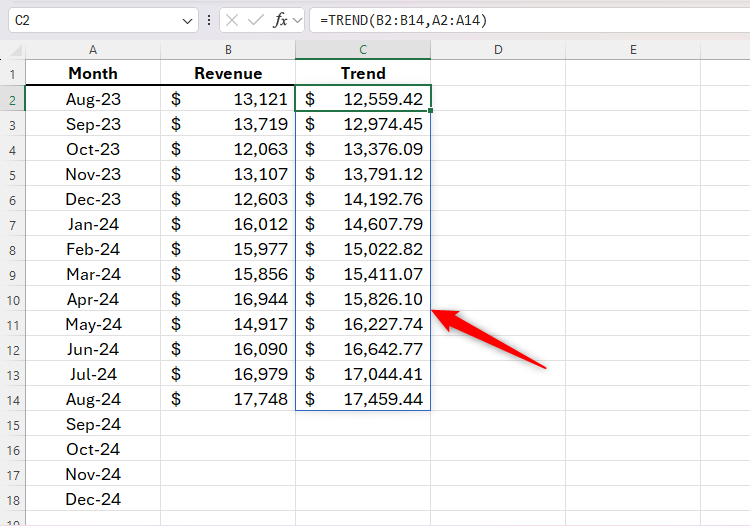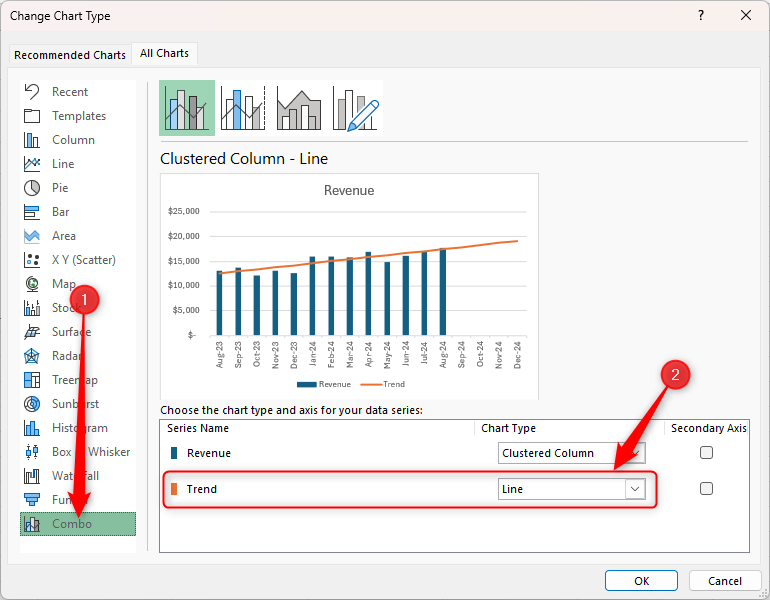How to Use the TREND Function in Excel
Quick Links
- What Is TREND Used For?
- How Does TREND Work?
- What Is the Syntax for TREND?
- Calculating Your Existing Data's Trend
- Predicting Future Figures
- Using TREND With Charts
One way to give more meaning to your numbers in Excel is to understand the trends lying behind them, and being able to do so is crucial in today's ever-changing world. Using Excel's TREND function will help you identify patterns in previous and current data, as well as project future movements.
What Is TREND Used For?
The TREND function has three primary uses in Excel:
- Calculate a linear trend through a set of existing data,
- Predict future figures based on existing data, and
- Create a trendline in a chart that helps you forecast future data.
TREND can be used to measure performance or forecast finances in the workplace, and you can also use it on your personal spreadsheets to track your spending, predict how many goals your team will score, and a host of other uses.
How Does TREND Work?
Excel's TREND function calculates what would be the line of best fit on a chart using the least-squares method.
The line of best fit is calculated using the equation
<em>y</em> = <em>mx</em> + <em>b</em>
where
- y is the dependent variable,
- m is the gradient (steepness) of the trendline,
- x is the independent variable, and
- b is the y-intercept (where the trendline crosses the y-axis)
While it's not essential to know this information, it's handy for choosing what you want to include in your TREND formula syntax.
What Is the Syntax for TREND?
Now that you understand what a trendline is and how it's calculated, let's look at the Excel formula.
TREND(<em>known_y's</em>,<em>known_x's</em>,<em>new_x's</em>,<em>const</em>)
where
- known_y's (required) are the dependent variables you already have that will help Excel calculate the trend. Without these, Excel can't calculate a trend, so your input would result in an error message. These values would sit on the y-axis on a column chart.
- known_x's (optional) are the independent variables that would sit on the x-axis on a column chart, and these must be the same length (number of cells) as the known_y's reference.
- new_x's (optional) is one or more sets of new independent variables on the x-axis for which you want Excel to calculate the trend. This tells Excel how many new y-values you want to add to your data.
- const (optional) is a logical value that defines the intercept (value b in y = mx b). FALSE forces the trendline to pass through 0 on the x-axis, while TRUE means the intercept is applied normally. Omitting this value is the same as inserting TRUE (normal).
Calculating Your Existing Data's Trend
It's now time to put this into action. In the example below, we have the revenue for each of the past few months, and we want to work out the trend for this data.

To do this, we need to type the following formula into cell C2:
<em>y</em> = <em>mx</em> + <em>b</em>
where B2:B14 are the known y-values, and A2:A14 are the known x-values. We don't need any new x-values at this point, as we aren't creating any forecast revenue data. Also, we don't need a const value, as setting the y-intercept at 0 would yield inaccurate data.
Press Enter after typing your formula, and see that the trend is displayed as an array.

Predicting Future Figures
Now that we have an idea of the trend of our data, we're ready to use this information to forecast the following months. In other words, we want to complete the trend column in our table.
So, in cell C15, we will type
<em>y</em> = <em>mx</em> + <em>b</em>
where B2:B14 are the known y-values, A2:A14 are the known x-values, and A15:A18 are the new x-values for the predictive trend we're calculating. We haven't specified a const value, as we want the y-intercept to calculate normally.
Press Enter to see the outcome.

Using TREND With Charts
Now that we have all the data up to the current date, as well as the predictive trendline for the coming month, we're ready to see how this looks on a chart.
Select all the data in your table, including the headings, and click "2D Clustered Column Chart" in the Insert tab on the ribbon.

At first, you will see both the independent variable (in our case, revenue) and the trendline on the x-axis, but we want the trend data to show as a line.

To amend this, click anywhere on the chart, and select "Change Chart Type" in the Chart Design tab on the ribbon.

Then, select the "Combo" chart type, and make sure your trendline is set to "Line."

Then, click "OK" to see your new chart with the trendline showing as you would expect, including as a projection for future months. We've also clicked " " in the corner of our chart to remove the data legend, as it's not necessary for this chart.

If you aren't looking to see future projections in your data, you can add a trendline to your chart without using the TREND function. Simply hover your cursor over the chart, click the " " in the top-right corner, and check "Trendline." Another way to see trends is to use Excel's Sparklines, which you can find in the Insert tab on the ribbon.
The above is the detailed content of How to Use the TREND Function in Excel. For more information, please follow other related articles on the PHP Chinese website!

Hot AI Tools

Undresser.AI Undress
AI-powered app for creating realistic nude photos

AI Clothes Remover
Online AI tool for removing clothes from photos.

Undress AI Tool
Undress images for free

Clothoff.io
AI clothes remover

Video Face Swap
Swap faces in any video effortlessly with our completely free AI face swap tool!

Hot Article

Hot Tools

Notepad++7.3.1
Easy-to-use and free code editor

SublimeText3 Chinese version
Chinese version, very easy to use

Zend Studio 13.0.1
Powerful PHP integrated development environment

Dreamweaver CS6
Visual web development tools

SublimeText3 Mac version
God-level code editing software (SublimeText3)

Hot Topics
 How to Create a Timeline Filter in Excel
Apr 03, 2025 am 03:51 AM
How to Create a Timeline Filter in Excel
Apr 03, 2025 am 03:51 AM
In Excel, using the timeline filter can display data by time period more efficiently, which is more convenient than using the filter button. The Timeline is a dynamic filtering option that allows you to quickly display data for a single date, month, quarter, or year. Step 1: Convert data to pivot table First, convert the original Excel data into a pivot table. Select any cell in the data table (formatted or not) and click PivotTable on the Insert tab of the ribbon. Related: How to Create Pivot Tables in Microsoft Excel Don't be intimidated by the pivot table! We will teach you basic skills that you can master in minutes. Related Articles In the dialog box, make sure the entire data range is selected (
 You Need to Know What the Hash Sign Does in Excel Formulas
Apr 08, 2025 am 12:55 AM
You Need to Know What the Hash Sign Does in Excel Formulas
Apr 08, 2025 am 12:55 AM
Excel Overflow Range Operator (#) enables formulas to be automatically adjusted to accommodate changes in overflow range size. This feature is only available for Microsoft 365 Excel for Windows or Mac. Common functions such as UNIQUE, COUNTIF, and SORTBY can be used in conjunction with overflow range operators to generate dynamic sortable lists. The pound sign (#) in the Excel formula is also called the overflow range operator, which instructs the program to consider all results in the overflow range. Therefore, even if the overflow range increases or decreases, the formula containing # will automatically reflect this change. How to list and sort unique values in Microsoft Excel
 If You Don't Rename Tables in Excel, Today's the Day to Start
Apr 15, 2025 am 12:58 AM
If You Don't Rename Tables in Excel, Today's the Day to Start
Apr 15, 2025 am 12:58 AM
Quick link Why should tables be named in Excel How to name a table in Excel Excel table naming rules and techniques By default, tables in Excel are named Table1, Table2, Table3, and so on. However, you don't have to stick to these tags. In fact, it would be better if you don't! In this quick guide, I will explain why you should always rename tables in Excel and show you how to do this. Why should tables be named in Excel While it may take some time to develop the habit of naming tables in Excel (if you don't usually do this), the following reasons illustrate today
 How to Format a Spilled Array in Excel
Apr 10, 2025 pm 12:01 PM
How to Format a Spilled Array in Excel
Apr 10, 2025 pm 12:01 PM
Use formula conditional formatting to handle overflow arrays in Excel Direct formatting of overflow arrays in Excel can cause problems, especially when the data shape or size changes. Formula-based conditional formatting rules allow automatic formatting to be adjusted when data parameters change. Adding a dollar sign ($) before a column reference applies a rule to all rows in the data. In Excel, you can apply direct formatting to the values or background of a cell to make the spreadsheet easier to read. However, when an Excel formula returns a set of values (called overflow arrays), applying direct formatting will cause problems if the size or shape of the data changes. Suppose you have this spreadsheet with overflow results from the PIVOTBY formula,
 Excel MATCH function with formula examples
Apr 15, 2025 am 11:21 AM
Excel MATCH function with formula examples
Apr 15, 2025 am 11:21 AM
This tutorial explains how to use MATCH function in Excel with formula examples. It also shows how to improve your lookup formulas by a making dynamic formula with VLOOKUP and MATCH. In Microsoft Excel, there are many different lookup/ref
 How to Use Excel's AGGREGATE Function to Refine Calculations
Apr 12, 2025 am 12:54 AM
How to Use Excel's AGGREGATE Function to Refine Calculations
Apr 12, 2025 am 12:54 AM
Quick Links The AGGREGATE Syntax
 How to change Excel table styles and remove table formatting
Apr 19, 2025 am 11:45 AM
How to change Excel table styles and remove table formatting
Apr 19, 2025 am 11:45 AM
This tutorial shows you how to quickly apply, modify, and remove Excel table styles while preserving all table functionalities. Want to make your Excel tables look exactly how you want? Read on! After creating an Excel table, the first step is usual







